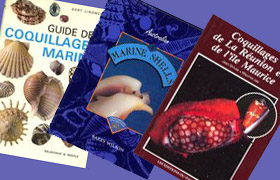
Following these few rules will help to perform identifications:
-1- Having exact data on the origin of the shell.
This is really important as species from different origins can look the same but are not. Moreover most people would consider
that a shell has little value without exact data, and this is especially true when trying to build a scientific collection such
as Conchylinet is aiming at. However if you have not collected the shell by yourself, you can always be doubtful of the
data you got from somebody else, but most of the serious collectors keep exact data with their specimen even if they can be
reluctant to give all of them.
-2- Having good quality shells.
Obviously the identification will be easier if the shell is in good condition. Most of the time it is better to have a badly broken shell
than a very worn one. I could identify species from a small chip with nice colour patterns and structures, but cannot do it with a full
but very erroded specimen that has lost its colours and features.
-3- Having several shells from the same location.
It is better to have a set of several shells that will cover individual variations than having a single specimen. It is true with genus
that look the same from one specie to the other (small Cerithiums, some Conus tribes, most of bivalves genus, etc.). However, you must
not overcollect live shells. Leave the species you already have and those you can identify in their natural environment.

|
The easiest way to identify species is to look for them in illustrated guides. Having several guides will give you more than one
figure of a specie, this can be interesting as the same specie can vary considerably. Moreover with several guides you can check
the identification you made from a first book against an other book. Little by little, when people is getting used to identify and when his species knowledge is growing, he will be faster to identify ending up in needing a book only for new or unusual species. |
Nowadays, Internet is a really good source for identifying species. This has been made possible both with the highspeed Internet
and the dropping price of digital cameras. Now, a lot of people can share pictures, build Intenet websites, share content over
forums... and this is just great!
Do not hesitate to use search engines to find seashells websites or to look for pictures to help in the identification of a specie.
Keep in mind that anybody can upload anything on Internet, so double-check everything before validating any id.
|
This science, started in the 18th century by Carl Linnaeus, gives the rules and a canva to name living species. Latin binomial names
are in use since this time. Species are refered with latin-like Genus and specie name. The problem (well... the fact) is that knowledge constanly increases and so are the methods to describe species. According to that, taxonomy is also always moving. As a consequence, you will find synonyms (i.e. the same specie will have different names in different references); in these cases, the best to do is to stick to one name and to keep tracks of the others (you can annotate your references with the genus and specie name you chose to keep). In the beginning, I suggest not to pay attention to subspecies or forms name that can follow the specie. This is for collecting purposes and has no scientific value. Moreover, following this to the extremities, every individuals could end up with a different name. |

Carl Linnaeus (Carl von LinnÚ) |